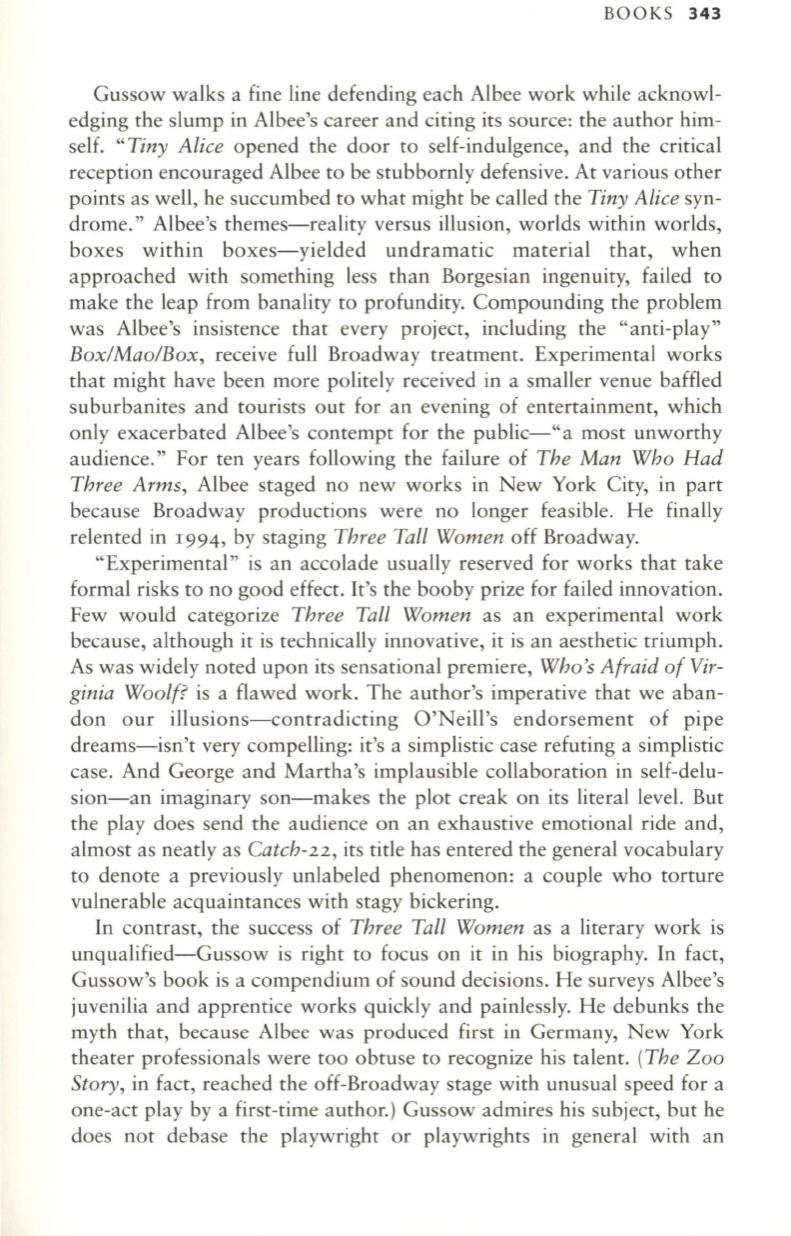
BOOKS
343
Gussow walks a fine line defending each Albee work while acknowl–
edging the slump in Albee's career and citing its source: the author him–
self.
"Tiny Alice
opened the door to self-indulgence, and the critical
reception encouraged Albee to be stubbornly defensive. At various other
points as well, he succumbed to what might be called the
Tiny Alice
syn–
drome." Albee's themes-reality versus illusion, worlds within worlds,
boxes within boxes-yielded undramatic material that, when
approached with something less than Borgesian ingenuity, failed to
make the leap from banality to profundity. Compounding the problem
was Albee's insistence that every project, including the "anti-play"
Box/Mao/Box,
receive full Broadway treatment. Experimental works
that might have been more politely received in a smaller venue baffled
suburbanites and tourists out for an evening of entertainment, which
only exacerbated Albee's contempt for the public-"a most unworthy
audience." For ten years following the failure of
The Man Who Had
Three Arms,
Albee staged no new works in New York City, in part
because Broadway productions were no longer feasible. He finally
relented in
I994,
by staging
Three Tall Women
off Broadway.
"Experimental" is an accolade usually reserved for works that take
formal risks to no good effect. It's the booby prize for failed innovation.
Few would categorize
Three Tall Women
as an experimental work
because, although it is technically innovative, it is an aesthetic triumph.
As was widely noted upon its sensational premiere,
Who's Afraid of Vir–
ginia Woolf?
is a flawed work. The author's imperative that we aban–
don our illusions-contradicting O'Neill's endorsement of pipe
dreams-isn't very compelling: it's a simplistic case refuting a simplistic
case. And George and Martha's implausible collaboration in self-delu–
sion-an imaginary son-makes the plot creak on its literal level. But
the play does send the audience on an exhaustive emotional ride and,
almost as neatly as
Catch-22,
its title has entered the general vocabulary
to denote a previously unlabeled phenomenon: a couple who torture
vulnerable acquaintances with stagy bickering.
In contrast, the success of
Three Tall Women
as a literary work is
unqualified-Gussow is right to focus on it in his biography. In fact,
Gussow's book is a compendium of sound decisions. He surveys Albee's
juvenilia and apprentice works quickly and painlessly. He debunks the
myth that, because Albee was produced first in Germany, New York
theater professionals were too obtuse to recognize his talent.
(The
Zoo
Story,
in fact, reached the off-Broadway stage with unusual speed for a
one-act play by a first-time author.) Gussow admires his subject, but he
does not debase the playwright or playwrights in general with an


